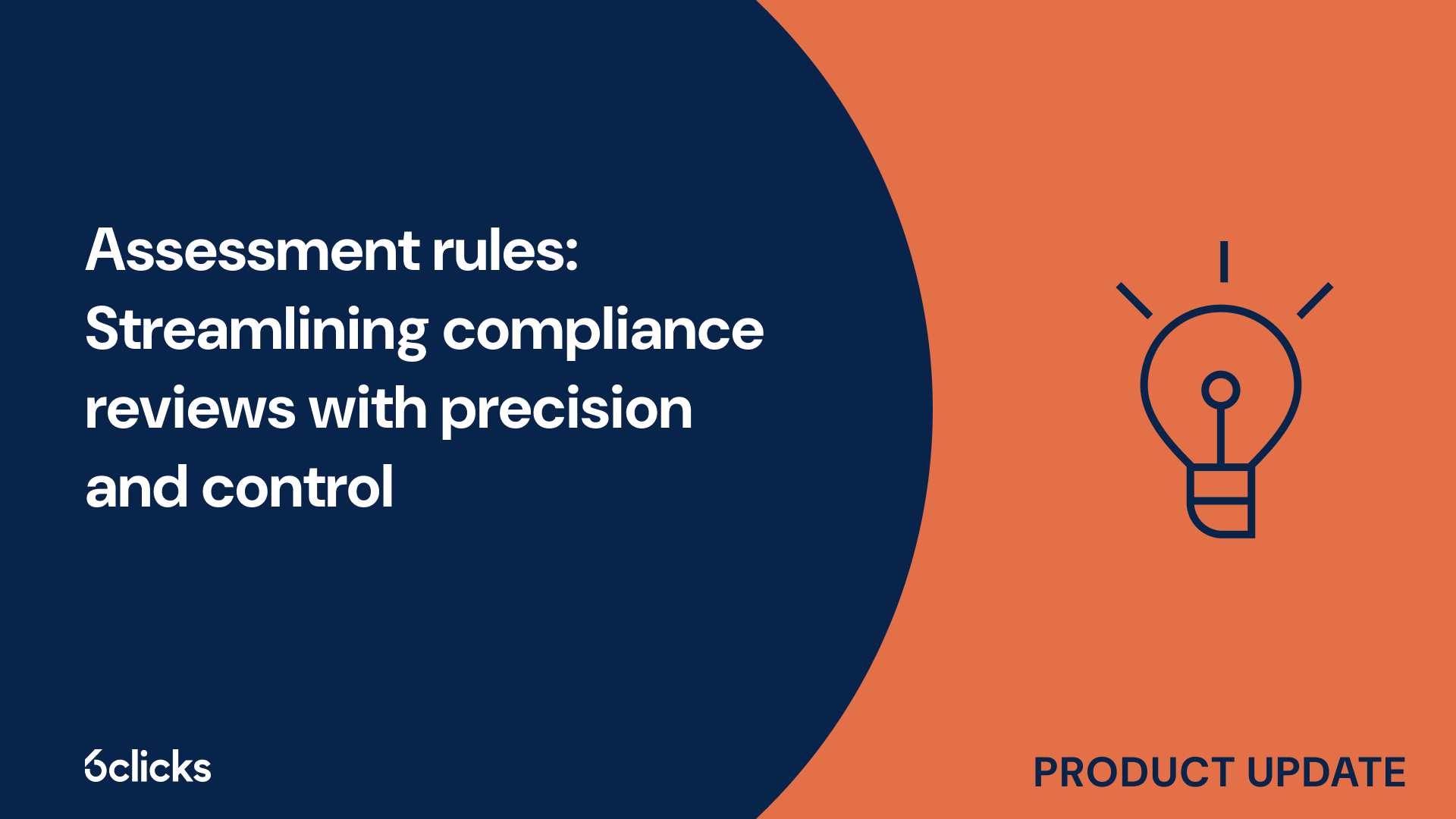The GRC buyer’s guide for 2025: Building resilience with AI-powered, federated solutions
Discover the ultimate GRC buyer's guide for 2025! Uncover how AI-powered, federated solutions transform compliance and security management for industries like government, aerospace, banking, and more. Learn about centralized control, continuous compliance, and advanced cyber GRC capabilities. Download now!
-1.png?width=200&height=249&name=Group%20193%20(1)-1.png)
The GRC buyer’s guide for 2025: Building resilience with AI-powered, federated solutions
Overview of financial services regulation in Australia
Australia’s financial services are tightly regulated to ensure system stability and consumer protection. The framework covers retail clients, banks, settlement facilities, and APRA-regulated entities, with strict licensing requirements for companies offering depository services, financial products, or payment facilities. Senior executives must act in clients' best interests, and regulations address areas such as consumer protection, misconduct, market conduct, and prudential standards. Insurance companies and financial advisors also face specific regulations. Overall, the regulatory system is designed to maintain market integrity and create a safe environment for both businesses and consumers.
Objectives of financial regulation in Australia
The primary goals of financial regulation in Australia are to maintain market integrity, protect consumers, ensure financial system stability, and regulate financial institutions. This involves preventing fraud, market manipulation, and misconduct while promoting fair and transparent markets. Consumer protection ensures financial advice is accurate and delivered by licensed professionals. Regulators like ASIC, APRA, and the Reserve Bank of Australia (RBA) monitor risks, set standards, and enforce regulations to prevent systemic disruptions.
Regulatory framework for financial services
The regulatory framework in Australia is a collaborative effort involving:
-
ASIC (Australian Securities and Investments Commission): Regulates investments, superannuation, and insurance conduct.
-
APRA (Australian Prudential Regulation Authority): Ensures financial institutions meet standards for capital adequacy and risk management.
-
RBA (Reserve Bank of Australia): Monitors the stability of the financial system, including payment systems.
Authorised Deposit-Taking Institutions (ADIs)
ADIs, including banks, credit unions, and building societies, are essential to Australia’s financial system and are regulated by APRA. ADIs must meet stringent capital adequacy, risk management, and governance standards. Larger banks face additional requirements, such as capital buffers during downturns. ADIs are also required to provide accurate financial disclosures and operate within set business scopes, including payment and depository services.
APRA-regulated entities
APRA regulates ADIs, insurance companies, and superannuation funds to ensure financial stability. It sets prudential standards to ensure these institutions maintain adequate financial resilience, manage risks, and meet solvency requirements. This protects consumers and ensures the financial system's integrity.
Licensing requirements
To operate as an Authorised Deposit-Taking Institution (ADI) in Australia, financial institutions must meet stringent licensing requirements set by the Australian Prudential Regulation Authority (APRA), designed to support financial system stability and resilience. Key requirements include:
Governance and risk management:
- Robust governance structure with clear accountability.
- Sound risk management practices to identify and mitigate risks effectively.
Restricted ADI Licence:
- APRA offers a Restricted ADI Licence for entities with limited activities and a smaller customer base.
- This phased approach enables new entrants to begin with minimal activities and grow responsibly.
Capital adequacy and compliance:
- Adequate capital levels to support financial stability.
- Compliance with APRA's prudential standards and guidelines.
- Financial institutions with a Restricted ADI Licence must achieve specific milestones set by APRA.
- Successful completion of these milestones can lead to an unrestricted ADI licence, allowing for a broader range of banking activities.
APRA’s role in consumer protection:
- Ensures that ADIs comply with prudential standards, maintaining safe operations.
- Safeguards consumer deposits and protects the integrity of the financial system.
Through these licensing requirements and updates, APRA promotes stability and resilience within the financial services industry, ensuring that ADIs operate safely and soundly to uphold consumer trust and system integrity.
Financial system stability
Financial system stability is central to Australia’s financial regulation. Regulators like APRA monitor risks in financial institutions, enforce prudential standards, and ensure adequate capital. By maintaining stability and promoting sound risk management, the regulatory system protects consumers and bolsters confidence in the financial services industry.
Core principles for soundness and integrity
Key principles emphasize stability and operational soundness through prudential standards:
-
Net Stable Funding Ratio (NSFR): Ensures institutions maintain stable funding relative to liquidity risks.
-
Liquidity Coverage Ratio (LCR): Requires institutions to have sufficient liquidity to withstand short-term financial stresses.
-
Risk management: These standards help manage financial risks, reducing the likelihood of market disruptions and supporting resilience.
Consumer protection
Consumer protection in Australia’s financial services is enforced through:
-
National Consumer Credit Protection Act 2009 (NCCPA): Mandates that financial institutions provide transparent information about fees, interest rates, and terms.
-
Responsible lending: Ensures lenders assess a consumer’s ability to repay loans and provide suitable credit products.
-
Regulatory developments: Focuses on transparency, accountability, and suitable access to financial products for consumers.
Business models in the financial services industry
Financial services operate under various business models, including banking, insurance, and financial advisory services. While each model generates revenue differently, all providers are subject to regulatory oversight to ensure market stability and consumer protection.
Risks in the financial services industry
The financial services industry faces a range of risks that institutions must manage effectively:
-
Market risk: Volatility in interest rates, exchange rates, and asset prices can impact investments.
-
Credit risk: Arises from potential loan defaults, managed through credit assessments and loan loss provisions.
-
Operational risk: Includes failures in systems, human error, and external events, requiring robust operational controls.
-
Compliance and regulatory risk: Ensures adherence to legal standards, with non-compliance resulting in fines and reputational damage.
-
Reputational risk: Ensuring ethical behavior and transparency to maintain public trust.
Operational risk management and compliance obligations
Operational risk management and compliance are critical components for financial institutions to ensure smooth operations, regulatory adherence, and customer trust. Key elements include:
Operational risk management:
- Focuses on mitigating risks from internal processes, systems failures, or human error.
- Requires a framework to identify, assess, and control potential disruptions.
- Includes regular risk assessments, robust internal controls, and investments in technology.
Compliance obligations:
- Entails adherence to laws and regulations designed to protect consumers and uphold market integrity.
- Involves monitoring regulatory changes, implementing policies, and conducting compliance audits.
- Requires staff training on compliance standards and procedures.
Importance of proactive management
Proactive operational risk management is essential for minimizing disruptions, ensuring service continuity, and protecting client interests. By identifying and addressing potential weaknesses in internal operations, financial institutions can reduce the likelihood of financial losses, reputational harm, and customer dissatisfaction. This approach helps maintain resilience against operational risks, safeguarding the institution's ability to provide reliable service.
Integrated approach benefits
An integrated approach to operational risk management and compliance streamlines processes, optimizes resource allocation, and improves overall efficiency. Aligning these efforts demonstrates a commitment to good governance and responsible business practices, enhancing the institution's reputation and fostering customer trust. This approach also positions institutions to respond quickly to regulatory changes and maintain compliance, reinforcing stability and integrity within the financial industry.
Licensing process for financial institutions
To legally operate in Australia’s financial services industry, institutions must go through a rigorous licensing process:
- Application requirements: Detailed information on business model, governance, and risk management.
- Evaluation by ASIC: Reviews financial stability, adherence to market integrity, and consumer protection obligations.
- Ongoing monitoring: Licensed entities must remain compliant to continue operating in the industry.
Australian companies operating a depository service
Australian companies that operate depository services play a key role in Australia's financial services landscape, ensuring the safekeeping and efficient management of financial assets. A depository service involves securely holding and administering securities, providing individuals, companies, and institutional investors with a trusted platform for asset storage and transactions.
These depository services are regulated by the Australian Securities and Investments Commission (ASIC) under the Financial Services Licensing framework. Companies wishing to provide depository services must obtain a financial services license from ASIC, which ensures they meet all regulatory standards and protect client interests.
Key licensing requirements:
-
Comprehensive application process: Companies must submit extensive details about their business model, operational procedures, risk management, and compliance systems.
-
Demonstration of financial stability and expertise: They must meet requirements for financial resources, staff qualifications, and robust internal systems.
-
Risk management and consumer protection: Authorities assess the company's ability to handle and secure financial assets and its commitment to market integrity and client protection.
Regulatory evaluation:
-
The evaluation process may include further documentation, site visits, and discussions.
-
The timeline varies depending on the complexity of the company's operations.
Post-licensing compliance:
Once licensed, companies are subject to ongoing monitoring by ASIC to ensure continued adherence to regulatory obligations. Through their compliance and secure service offerings, depository service providers support the integrity and stability of the financial system, offering investors a reliable platform for managing assets.
Summary
Australia’s financial services are tightly regulated to ensure stability, consumer protection, and market integrity. Key regulators like APRA, ASIC, and the RBA enforce strict requirements for financial institutions, including governance, risk management, and compliance standards. This helps maintain financial stability, transparency, and consumer trust while safeguarding against fraud and misconduct.
The regulatory system ensures that institutions, such as ADIs, operate safely and meet industry standards, protecting client interests and supporting the financial system’s integrity. This oversight fosters a secure environment for investors and consumers, promoting confidence in Australia’s financial services industry.







